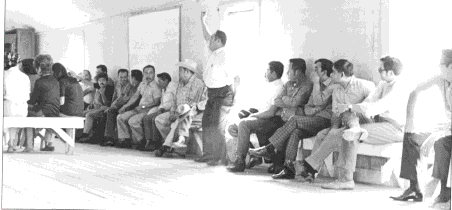
by Claire Peterson and Susana Diaz

© Apple Computer
"The consumer boycott is the only open door in the dark corridor of nothingness down which farm workers have had to walk for many years. It is a gate of hope through which they expect to find the sunlight of a better life for themselves and their families." (Cesar Chavez)
The disastrous great depression left many people unemployed. As a result, a large number of caucasian people took over many migrant workers' jobs in California. This left many Mexicans and Filipinos desperate and willing to do anything for money. Working conditions were poor for the huge population of migrant workers and illegal immigrants. There were unsanitary conditions and horrible wages. These conditions evoked anger between workers and employers and set the foundation for large-scale wage strikes for the next fifty years.
In the 1930's drought struck the southwest which forced more needy workers to move to California farms. Because of a greater demand for labor from these workers, farmers lowered wages and hired more people. In 1951 Public Law 78 was passed which connected workers in Mexico to farms in the U.S. This allowed U.S. farmers to hire "braceros" when there was a shortage of domestic farmhands. Farmers took advantage of this law by hiring mostly braceros because they would work longer days for less pay, and would tolerate the working conditions.
 |
 |
Figure 1: Cesar Chavez participating in a march (left), Workers marching in protest (right).
Sometimes, whole families of "braceros" would only get paid twenty cents for three hours of work. Working families lived in small run down shacks or tents in crowded camps. If there wasn't enough room, some family members would sleep under bridges near by. In order to survive, families were forced to move to where work was available.

Figure 2: Workers in an organizing meeting.
By 1964 a movement arose and the union United Farm Workers Association (UFWA) was formed with 1,000 members. The farm workers wanted better wages and better working and living conditions. In August 1965, an independent walkout of Mexican and Filipino grape workers in Delano, California caught the leader and organizer of the UFW, Cesar Chavez's attention. An even larger strike led by the Filipinos against all the grape companies in the Delano area was supported by UFWA. When the strike was not successful in completely halting field work, Chavez organized a march to California's state capitol to inspire farm workers to join the Union. The march was effective in getting national attention, however, Chavez knew that neither the march nor the strike would be effective in getting the grape producers to negotiate. UFWA then decided to call a boycott of the Schenley Liquor Company who owned the vast majority of the vineyards in the San Joaquin Valley. This was a success and soon other grape producers were forced to sign contracts. Chavez sent representatives throughout the country to coordinate boycott meetings and fundraising efforts. For the next four years the United Farm Workers Organizing Committee decided to boycott all table grapes; this received wide public support. This boycott was the most successful in American history. In 1970 the pressure of the ongoing boycott resulted in the signing of contracts that provided workers with significant benefits.

Figure 3: The union contracts are signed!
To find out more about the history of UFWA and Cesar Chavez, try the following:
Pictures:
introduction | history | simulation | agent descriptions | UFW news | thinkquest